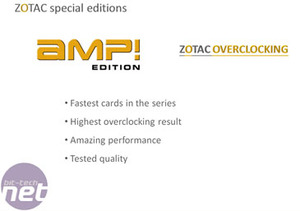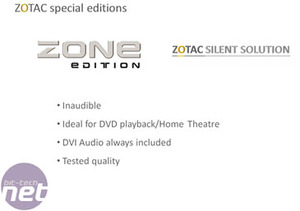Zotac GeForce 8600 GT ZONE Edition 256MB
Manufacturer: ZotacCore Clock: 540MHz
Shader Clock: 1180MHz
Memory Clock: 1400MHz (effective)
Warranty: Two years (parts and labour) in Europe (at time of publication)
UK Price (as reviewed): £87.24 (inc. VAT)
Zotac is a company that we’ve given a bit of coverage to on the pages of bit-tech since the company officially launched itself at this year’s Computex tradeshow in Taipei City, Taiwan. For those not familiar with Zotac though, it’s (another) Nvidia add-in card partner attempting to break into the market.
However, unlike some of the new additions to Nvidia’s extensive list of board partners, Zotac is going about things slightly differently. Instead of potentially upsetting the other players in the Nvidia-based graphics card market with low prices like some of the newer partners, it is trying deliver products that aren’t just another slew of reference designs. After all, we’ve already got enough of those on the market and thankfully Zotac acknowledges that fact.
Despite being a relatively new player in the graphics card market, Zotac also has huge manufacturing power behind it, being a subsidiary of PC Partner, the company that is also behind Sapphire – ATI’s largest graphics card partner. In addition to manufacturing both Zotac’s and Sapphire’s graphics cards, PC Partner is also still contracted to produce most of the ATI graphics cards on the market for AMD’s various add-in board partners.


The last Zotac graphics card we reviewed was part of the company’s AMP! family, which is focused on pumping up the volume... Errr, I mean, clock speeds – offering something over and above the Nvidia reference design from that standpoint. In the process, Zotac says inthat it pushes the clock speeds as high as possible without compromising on quality or stability.
As always though, there’s another side to the coin and in Zotac’s case, this is the ZONE family. This series of cards move away from Nvidia’s reference designs in the opposite direction, moving the focus to silence and Home Theatre capabilities. As a result, Zotac offers a range of silent cooling solutions on these cards in addition to DVI audio too.
Today, we’re here to report on the company’s GeForce 8600 GT ZONE edition, which we’ve been testing for a few weeks now. Without further ado, let’s enter the ZONE...
Box & Bundle:
I seem to remember my first impressions of the box were something along the lines of “is that all?”. Yes, the box is small and many would consider it to be a pretty insignificant part of the product, but it’s important that your graphics card arrives in one piece – there’s nothing worse than something being damaged during transit from both perspectives.It frustrates the consumer, because they cannot use the product they’ve just purchased, and secondly, it means the manufacturer has to deal with returns for reasons that can be controlled to an extent. So, despite the box for Zotac’s box appearing a little insignificant at first sight, it does its job fairly well.
The bundled extras are packed in a separate compartment to the card and the latter is tightly sandwiched between two pieces of densely packed corrugated cardboard inside an anti-static bag. We’d like to see some thicker cardboard used for the box, but in all honesty, the card is secure and unlikely to be smashed around enough to damage it during transit.
In addition to the card, there are a few bundled extras, including DVI-to-VGA and DVI-to-HDMI converters, a S/PDIF cable, an S-Video/Component combo cable, a driver CD and an instruction manual. The most notable inclusion is the DVI to HDMI converter, as we briefly mentioned that all of Zotac’s ZONE series cards would be able to pass audio over DVI and this is the gizmo that helps to make that possible, but it isn’t all that is required.
With AMD’s Radeon HD 2600- and HD 2400-series graphics cards, there is an audio controller inside the company’s Unified Video Decoder and this allows the card to pass audio from the audio codec to the HDMI connection (on the graphics card) without needing any additional connectors. Because Nvidia’s graphics cards currently don’t support this feature, a S/PDIF connector is required to pass the audio from the audio codec to the graphics card (and thus to the HDMI port) – this is included in the box and works well providing your motherboard or soundcard has a pin header for S/PDIF out.

MSI MPG Velox 100R Chassis Review
October 14 2021 | 15:04













Want to comment? Please log in.